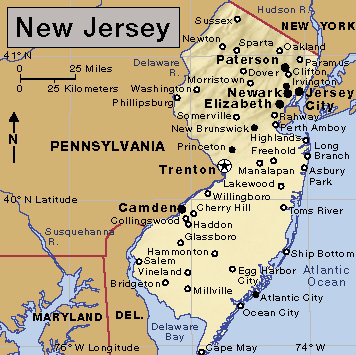Jersey City << JUR zee >>, New Jersey (pop. 292,449), is a major seaport and industrial and transportation center of the New York-Newark-Jersey City metropolitan area. It ranks second to Newark as the largest city in New Jersey. Jersey City is located across the Hudson River from New York City.

During the 1630’s, Dutch settlers arrived in what is now the Jersey City area. The English took control of the area in 1664. They named the city for Jersey, the largest of the Channel Islands in the English Channel off the coast of France.
Description.
Jersey City is the county seat of Hudson County, and its land area covers about 15 square miles (39 square kilometers). It is the home of New Jersey City University and St. Peter’s University. Old Bergen Church, a landmark of the city, was completed in 1660. 99 Hudson, a condominium tower completed in 2020, is New Jersey’s tallest building. It rises 900 feet (270 meters).

Economy.
Jersey City has hundreds of factories. Its leading industries produce chemicals, clothing, electrical equipment, food products, paper products, and textile products.
Much traffic to and from New York City passes through Jersey City. Tunnels under the Hudson River serve cars, buses, trucks, and trains traveling between the two cities. Millions of motor vehicles use the Holland Tunnel yearly. The Pulaski Skyway connects Jersey City and Newark. The Jersey City waterfront has a large terminal for container cargo. The terminal is part of a development called Port Jersey.
Government and history.
Jersey City has a mayor-council form of government. The voters elect the mayor and the nine council members to four-year terms.
Delaware Indians lived in what is now the Jersey City area before the Dutch set up a trading post there in the 1620’s. The post grew into a settlement that became known as Paulus Hook.
The community was incorporated as Jersey City in 1820. Two railroad terminals were established there in 1834 and helped bring industry to the area. That same year, a treaty made the middle of the Hudson River the boundary between New York and New Jersey and gave Jersey City control of its own waterfront. Rapid industrial growth caused the city’s population to rise from 6,856 in 1850 to 29,226 in 1860.
The Hudson Tubes, the first railroad tunnel between Jersey City and New York City, linked the cities in 1909. The Holland Tunnel opened in 1927. Frank Hague, one of the nation’s last city political “bosses,” served as mayor of Jersey City from 1917 until 1947. The city’s population reached 299,017 in 1950. The population declined from the 1950’s through the 1980’s because many people and businesses moved to the suburbs. Since 1990, however, the city’s population has increased.
The Journal Square Transportation Center, which consists of a rapid transit railroad station, bus terminal, and shopping area, opened in 1974. In the 1980’s, Jersey City began an extensive redevelopment program. This program, continuing into the 2000’s, has increased the city’s affordable commercial and residential space and has attracted many corporations to the city.
